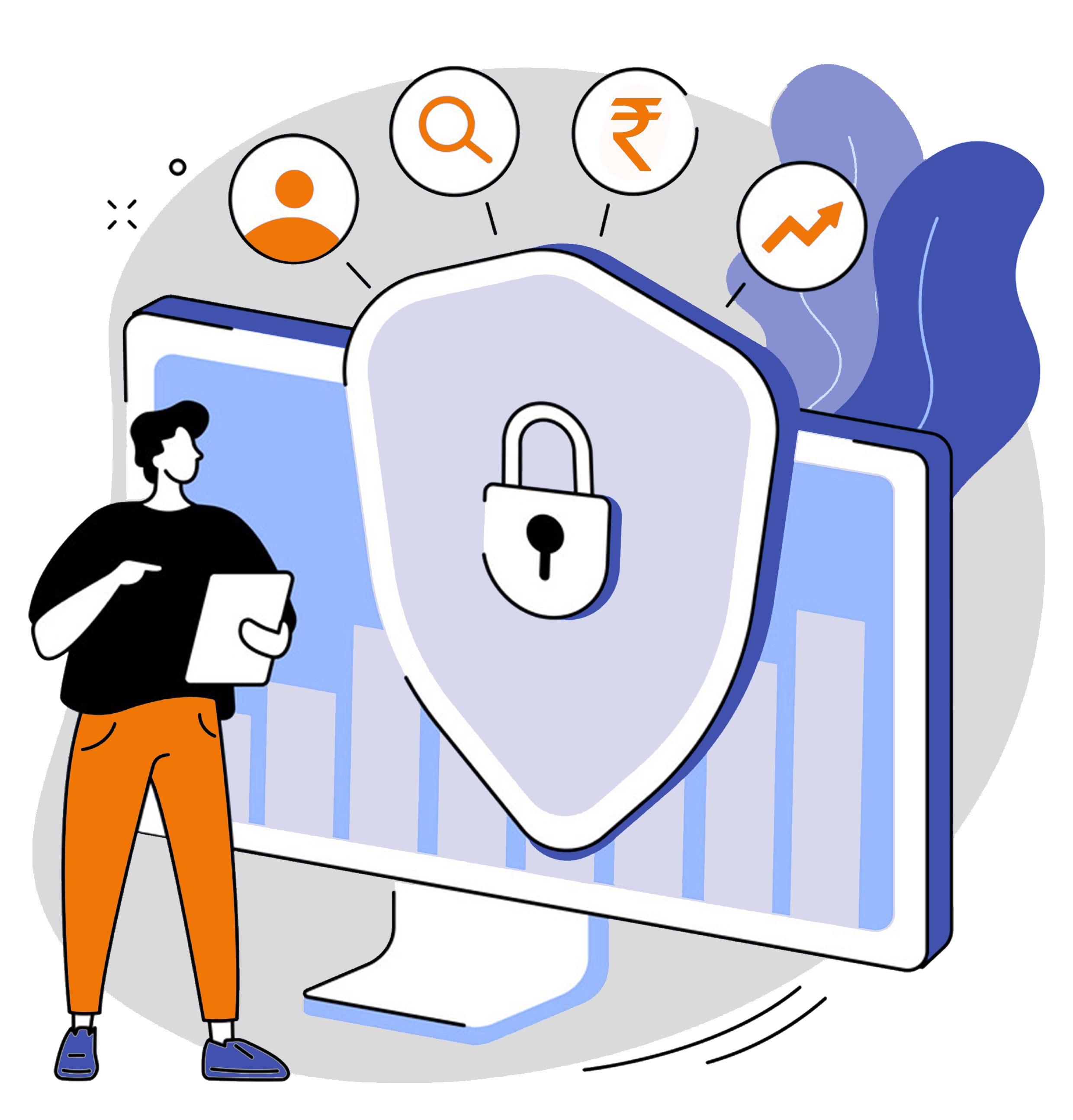Cyber Security Risk Mitigation And Management , Simplified
Vigilance is Key
In an era dominated by technological advancements, effective cyber security risk mitigation and management are paramount. Safeguard your digital assets with proactive measures, employing robust protocols and cutting-edge innovations. Implementing Two-Factor Authentication and Blockchain innovations strengthens defenses, fortifying your system against potential threats. Stay ahead in the cybersecurity landscape, prioritizing vigilance, and embracing the power of innovative solutions for a resilient and secure digital future.

Our Cyber Security Services Portfolio
Why to Choose Us ?

NEED CYBER SECURITY THAT'S SIMPLE, AFFORDABLE AND ACCESSIBLE ?
LEARN HOW TO TRANSFORM YOUR CYBER SECURITY WITH 2B SECURITY SERVICES
Frequently Asked Question's

System, network, and program security refers to safeguarding them against cyberattacks. A cyberattack typically involves accessing, editing, or destroying sensitive data, extorting money from users via ransomware, and disrupting normal business processes. It protects systems, networks, and technologies against unauthorized exploitation, reducing the risk of cyber attacks. You can use this term in a variety of contexts, from small business to mobile computing, and there are lots of different ways to categorize it.
The core components of cyber security systems will be artificial intelligence and machine learning. Organizations can also prevent threats before they become issues by using AI and ML to identify patterns and anomalies that indicate threats.
- Other trends in the scope of cyber security include:
- A focus on cyber warfare threats
- More hackers to deal with
- Developing cyber security talent
- Legacy tech continues to be an issue.
Cybersecurity is considered to be one of the primary factors that determine third-party transactions and business relationships by 60% of organizations.
The majority of enterprises adopt a security service edge platform that unifies web, cloud, and private application access.
USBs are becoming a more serious threat
All kinds of data, including personally identifiable information, protected health information, and personal information, are protected from theft and damage with cyber security, which is why it is so important.
Governments and industries have a variety of information systems, including sensitive data, personally identifiable information (PII), protected health information (PHI), personal information, intellectual property, and intellectual property. For your organization to become an easy target for cyber attackers, you need to have a cyber security system in place.
A vulnerability in cyber security refers to any weakness in an information system, system processes, or internal controls of an organization. These vulnerabilities are targets for lurking cybercrimes and are open to exploitation through the points of vulnerability.
Cybersecurity information vulnerabilities are extremely important to monitor for the overall security posture, as gaps in a network can result in a full-scale breach of systems in an organization.
Types of Cyber Vulnerability
Misconfigurations
Unsecured APIs
Outdated or Unpatched Software
Zero-day Vulnerabilities
Weak or Stolen User Credentials
Access Control or Unauthorized Access
Misunderstanding the “Shared Responsibility Model”
Cyber security threats refer to actions taken by individuals or organizations with malicious intent, intending to steal data, damage systems, or disrupt these systems in some way. You'll find malware, social engineering, man-in-the-middle attacks, denial of service attacks, and injection attacks as cyber threats.
Viruses, worms, Trojan horses, ransomware, cryptojacking, spyware, adware, fileless malware, and rootkits are some of the types of malware.
Security information and event management (SIEM) is a cyber security software solution that combines security information management (SIM) and security event management (SEM). SIEM provides real-time analysis of security alerts generated by cyber security applications and network hardware.
SIEM supports threat detection, compliance, and security incident management. It collects and analyzes security events, as well as other event and contextual data sources. SIEM collects security data from Network devices, Servers, and Domain controllers.
SIEM includes Cloud security, Cloud workload protection, Frontline workers, Identity network access, Critical infrastructure, Information protection governance, IoT security, Passwordless authentication
A honeypot is an intentionally compromised computer system that allows attackers to exploit flaws in any application by running it on virtualization technology. It is usually designed in such a way that it minimizes the chances of the team becoming compromised if the plan is implemented as planned.
Honeypots are network-attached systems that act as decoys to attract cyber-attackers:
Detect and study the tricks and types of cyber security threats used by hackers
Gain information all about cyber security and cyber criminals and the way they are operating Distract cybercriminals from other targets
Improve security policies
The types of honeypots include deception technology, malware, spam, email traps, database honeypots, and industrial control systems honeypots.
Data breaches, insider threats, malware, phishing, DDoS attacks, and more are all protected by cyber security. A comprehensive security system guards against SQL injections, zero-day exploits, password attacks, and social engineering attacks.
It also protects against IoT vulnerabilities and fileless attacks. Cyber security, including encryption, access controls, and regular updates, mitigates risks and protects sensitive data and networks from a variety of cyber threats. However, no system is entirely impervious to them.
Cybersecurity is becoming increasingly important in our society due to technology's increasing importance. Because cyber security protects all types of data against theft and damage, it is also essential to safeguard all kinds of data.
Personal information, protected health information (PHI), personal data, copyright, and personal information are all types of sensitive information that are stored in data systems that serve the public and private sectors. Cybercriminals will be able to target your company easily if you do not have a cyber security system in place.
Identity theft is when you steal someone else's personal information and use it for your gain without their permission. No matter how identity theft is defined, identification theft poses a threat to a target's financial stability, track record, and prospects. Different forms of identity theft exist, and each has a distinct impact on the target.
Information such as name, social security number, driver's license number, credit card number, and transactional information is used in identity theft.
A security incident, or security event, is any digital or physical breach that threatens the confidentiality, integrity, or availability of an organization’s information systems or sensitive data. Security incidents can range from intentional cyberattacks by hackers or unauthorized users to unintentional violations of a cyber security policy by legitimate authorized users.
Incident response plans typically outline security solutions that incident response teams must have in place to perform or automate key incident response workflows, such as gathering and correlating security data, detecting incidents in real-time, and responding to in-progress attacks.
SOC (Security Operation Centers) in cyber security are centralized functions within organizations that employ people, processes, and technology to continuously monitor an organization's security posture prevent, detect, analyze, and respond to cyber security threats.
SOCs serve as central command posts for an organization's IT infrastructure, including networks, appliances, devices, and information storage, wherever they may be. As a consequence of the proliferation of advanced threats, security operations centers serve as a point of correlation for all events logged within an organization. They manage and respond to each incident.

